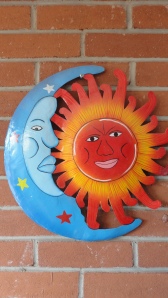 The last time I read Graham Greene, it was Our Man in Havana, in 2003, in Key West. Pregnant with Three, I thought, This is the last time I’ll be able to sit by a pool reading a novel for the next seven years. And so it came to pass. Luckily it was a good novel, and so is The End of the Affair. Clarity first, the fancy stuff later, Frank Conroy always counseled, and Greene is a consummate model of clarity:
The last time I read Graham Greene, it was Our Man in Havana, in 2003, in Key West. Pregnant with Three, I thought, This is the last time I’ll be able to sit by a pool reading a novel for the next seven years. And so it came to pass. Luckily it was a good novel, and so is The End of the Affair. Clarity first, the fancy stuff later, Frank Conroy always counseled, and Greene is a consummate model of clarity:
I looked at Henry’s chief. He was a man called Dunstan. He had a broken nose and his battered face looked like a potter’s error–a rejected-for-export face.
I keep writing about metal objects when I should switch to pottery or yarn or moss. Ah, but then the forbidden compels. Sun and Moon is painted tinware, bought in Key West, along with shells, and breakfast among roosters, a walk to Elizabeth Bishop’s house, the sight of Hemingway’s typewriter, flip-flops and Cuban sandwiches. We have also bought tinware in Austin and St. Paul de Vence, and it reminds me of the ability to travel.
The sun and moon appear incurably unhappy, though they were the sunniest ones in that bungalow souvenir shop. Maybe we should look elsewhere, I thought, at other bungalow souvenir shops, but one doesn’t want to spend excessive time on souvenir hunting, which should occur lightly and serendipitously, not deliberately and laboriously. Especially with One and Two sighing and picking up the breakables and complaining of thirst. I picked the happiest one. Husband Moon is formidably disapproving, and Mother Sun is vexed. Somehow this reminds me of Husband once telling me I should keep my hair gray as evidence of all that we had endured. Hysterical. I refuse.
Bright colors give Sun and Moon an air of happiness, and I contemplated its painter, and whether he or she was trying to trick us, the blues and reds distracting from the essence of the piece. Was it a message that the sun and moon are unsmiling gods? (After watching “Melancholia,” the sight of the daylit coin of moon is frightening.) In any case, appearances are important and can even cause internal change–just as my supermom outfit makes me feel, truly feel, that I can do four loads of laundry today, fill in the holes dug by blond-fluffy-dog (oh he is lucky to appear cute) that may kill my new roses, run by the post office, clean the cat litter, empty the dishwasher, and cook dinner while running a little domestic hospital for boy-with-a-splint and boy-with-a-cold. French toast, anyone? The best French toast can be found in Key West, with chickens pecking in the dirt, jacaranda branches above, hot coffee with chicory. The world is full of such seductions–
We have lingered in the chambers of the sea
By sea-girls wreathed with seaweed red and brown
Till human voices wake us, and we drown.
That’s the end of “The Love Song of J. Alfred Prufrock,” by Eliot, which I saw scratched into the paint of a bathroom stall door circa 1984 in the women’s room in Gilmore Hall at Johns Hopkins University. Which is exactly why I went to a good college: high-quality graffiti. Oldest child wants to memorize the whole of “Prufrock,” and when she returns from Seattle I look forward to making a pageant of it, with mnemonic hand gestures.
